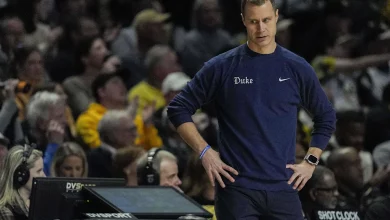Mark Stoops expects that roster changes and stable staff will lead to favorable improvements, fostering a positive shift in team performance and overall program development.

In the highly competitive realm of college football, success is often a delicate balance of various factors, including talent acquisition, coaching stability, team chemistry, and strategic development. For the Kentucky Wildcats, head coach Mark Stoops embodies a vision that emphasizes the importance of roster turnover and staff continuity as pivotal elements in driving positive change within the program. His belief is rooted in the understanding that strategic changes in player personnel combined with a stable coaching staff can catalyze improvements in team performance, foster a cohesive culture, and establish a sustainable foundation for future success. This comprehensive approach reflects a nuanced understanding of program building, where adaptability and consistency work hand-in-hand to elevate a team’s competitive standing.
The Role of Roster Turnover in Building a Dynamic Program
Roster turnover, often viewed with a mix of optimism and caution, is a critical component of modern college football. It involves the systematic replacing or retooling of players through recruiting, transfers, and player development to address the team’s evolving needs. Mark Stoops recognizes that strategic roster changes can invigorate a team by bringing in fresh talent, addressing positional gaps, and injecting new energy into the roster. This process is essential for several reasons:
Incorporating Fresh Talent: College football rosters are in constant flux due to graduations, injuries, and transfers. Bringing in new players allows the team to fill immediate gaps and improve overall talent levels. For Kentucky, recruiting talented high school prospects and attracting transfer portal players enhances the team’s competitiveness.
Addressing Positional Needs: Roster turnover enables coaches to target specific positions that require reinforcement, whether it’s to replace aging veterans, add depth in critical areas, or bring in playmakers to elevate the team’s overall performance.
Creating Competition: New players foster a competitive environment, pushing existing starters to improve and ensuring that the best performers earn their spots. This competitive culture is vital for sustained excellence.
Adapting to Scheme Changes: As coaching strategies evolve, roster adjustments are often necessary to align personnel with new schemes or tactical philosophies.
Long-Term Stability: While turnover might seem disruptive in the short term, strategically managing it ensures the team stays adaptable, dynamic, and resilient over time.
Mark Stoops’ approach to roster management emphasizes the importance of balancing continuity with necessary change. He understands that too much turnover can cause instability and hinder team cohesion, but strategic additions and departures can serve as catalysts for improvement. By carefully selecting transfers and high school recruits, Kentucky aims to craft a roster that is both talented and adaptable, capable of competing at the highest levels.
The Significance of Staff Continuity in Program Development
While roster changes are vital, staffing stability is equally critical to fostering positive change. Mark Stoops’ emphasis on staff continuity stems from the recognition that coaches and support personnel are the custodians of a team’s culture, identity, and strategic execution. A stable coaching staff provides several advantages:
Consistency in Philosophy: Long-term staff members develop a shared understanding of the program’s vision, standards, and tactical approach. This consistency ensures that players receive a coherent message and training, leading to more effective development and performance.
Player Development: Coaches who remain with the program over multiple seasons can monitor player growth, tailor their training, and build meaningful relationships, resulting in improved individual and team performance.
Recruiting Relationships: Stability in coaching personnel fosters trust and rapport with recruits, high school coaches, and the wider football community. This continuity enhances recruiting efforts and helps attract top talent.
Institutional Knowledge: Experienced staff members possess valuable institutional knowledge about the program’s history, culture, and operational nuances, enabling smoother transitions and decision-making.
Building a Cohesive Culture: Staff stability contributes to cultivating a positive, disciplined, and motivated team environment. A consistent leadership presence helps reinforce core values and instills a sense of shared purpose.
Mark Stoops’ focus on maintaining a stable coaching staff reflects his understanding that enduring relationships and shared philosophies are foundational to sustained success. He recognizes that frequent staff turnover can cause disruptions, dilute institutional knowledge, and undermine team cohesion.
Synergistic Impact of Roster Turnover and Staff Continuity
When combined effectively, roster turnover and staff stability can produce a synergistic effect, amplifying the positive trajectory of a football program. This dual approach allows Kentucky to adapt to changing circumstances while maintaining a consistent vision and culture. The strategic infusion of new players energizes the team and addresses immediate talent needs, while the experienced coaching staff ensures that these players are developed within a clear tactical framework. Conversely, staff stability ensures that new recruits and transfer players are integrated smoothly into the existing team culture and strategic system.
This dynamic fosters several key benefits:
Enhanced Performance: The infusion of talented, motivated players coupled with knowledgeable coaching results in improved on-field performance, including better execution, discipline, and strategic adaptability.
Development of a Winning Culture: Continuity in coaching staff reinforces a culture of accountability and excellence, which, combined with fresh talent, creates a winning environment that attracts future recruits.
Long-Term Sustainability: This balanced approach ensures that improvements are not fleeting but embedded within the program’s DNA, leading to sustained success over multiple seasons.
Resilience and Flexibility: The team becomes more resilient to setbacks such as injuries or tough opponents, thanks to the adaptable roster and experienced leadership.
Practical Strategies and Implementation
Mark Stoops’ vision involves deliberate planning and execution to realize these benefits. Some practical strategies include:
Targeted Recruiting: Focusing on high-character, versatile players who can adapt to multiple roles and schemes, ensuring roster flexibility.
Player Development Programs: Investing in coaching that emphasizes holistic development—strength, technique, football IQ, and leadership—to maximize the potential of both new and existing players.
Staff Development and Retention: Creating an environment that encourages staff longevity through professional growth opportunities, competitive compensation, and a positive working culture.
Clear Vision and Philosophy: Communicating a consistent program philosophy that aligns players and coaches, fostering unity and purpose.
Monitoring and Adjusting: Regularly assessing roster needs and coaching performance to make informed adjustments, ensuring that the program remains agile and aligned with long-term goals.
Cultural and Psychological Considerations
Beyond tactical and strategic aspects, the combination of roster turnover and staff continuity impacts the team’s culture and psychology. Players thrive in an environment of stability paired with opportunities for growth. When coaching staff members show commitment and consistency, players develop trust and confidence in their leadership. The introduction of new players invigorates the team’s dynamics, fostering a culture of competition and continuous improvement.
Stability also reduces uncertainty and anxiety among players, allowing them to focus on their development and performance. Meanwhile, strategic roster turnover injects fresh motivation and a sense of purpose, energizing the locker room.
Challenges and Risks
While the vision is promising, it is not without challenges. Roster turnover can lead to a period of adjustment, and too much change may disrupt team chemistry. Conversely, excessive staff stability without periodic evaluation might result in stagnation or complacency. Balancing these factors requires careful oversight, strategic planning, and a willingness to adapt when necessary.
Furthermore, external factors such as NCAA regulations, transfer portal dynamics, and recruiting competition influence the effectiveness of these strategies. Mark Stoops’ leadership involves navigating these complexities thoughtfully to maximize positive outcomes.
A Holistic Approach to Program Building
In summary, Mark Stoops’ belief that roster turnover coupled with staff stability will lead to positive change underscores a holistic approach to football program development. It recognizes that sustained success results from a delicate interplay of talent infusion, strategic consistency, cultural stability, and continual adaptation. This philosophy emphasizes that building a competitive, resilient, and cohesive team requires both embracing change where needed and maintaining stability where it matters most.
By focusing on strategic roster management and fostering a stable coaching environment, Kentucky aims to improve team performance, develop a strong program identity, and lay the groundwork for long-term excellence. This approach reflects a nuanced understanding of the complex dynamics involved in college football success and demonstrates Stoops’ commitment to continuous growth and improvement within the Wildcats’ football program.









